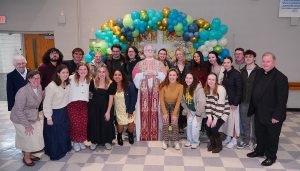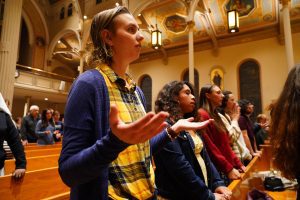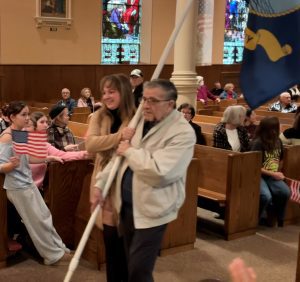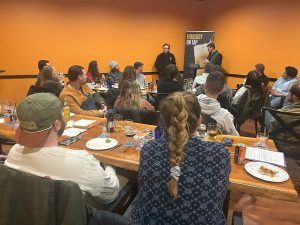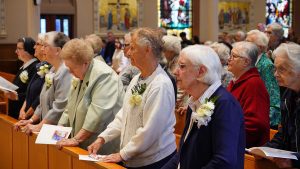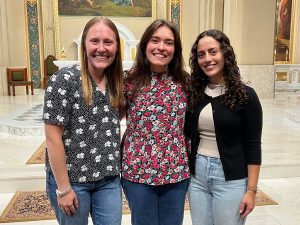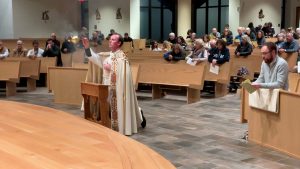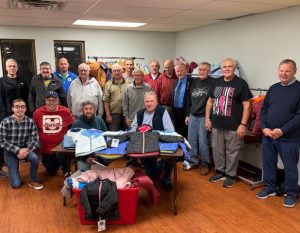SCRANTON – Representatives from nearly a dozen parish communities across the Diocese of Scranton gathered on Saturday, Nov. 15, 2025, for a Hispanic Ministry Convocation that marked a key step in the process of creating a new Diocesan Pastoral Plan for Hispanic Ministry.
The Convocation, held at the Diocesan Pastoral Center in Scranton, brought together parish leaders, pastors, and the Most Rev. Joseph C. Bambera, Bishop of Scranton, to review months of consultation and discern concrete goals and action steps for the growing Hispanic community.
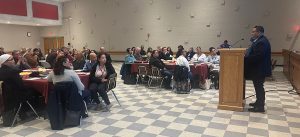
“The purpose of the Convocation is the last, final step in the consultative process for our Hispanic Ministry Pastoral Plan that we are working on,” Felix Martinez, Diocesan Director of Hispanic Ministry, said.
Over the last year, parish “consultative assemblies” have been held in each community where Hispanic ministry is present, allowing parishioners to identify their most pressing needs and priorities.
The consultations consistently highlighted themes such as spiritual growth, cultural integrity, family life, leadership development, and parish integration.
“We wanted to hear from them to see what are the most important objectives and needs of the Hispanic community,” Martinez added. “Most of the goals that were proposed, many agreed that they should be included in the pastoral plan. We’re really happy that we’ve made it to this point and are looking forward to the outcome.”
In between morning and afternoon work sessions, participants gathered for Mass at the Cathedral of Saint Peter. Bishop Bambera preached on the vital role that Hispanic Catholics play in the life of our local Church.
Calling the gathering “a day of great pride,” the Bishop thanked participants for their “hard work and effort” in shaping the pastoral plan and emphasized that the Hispanic community is “a vital part of our Diocese.”
“The depth of your faith both encourages and challenges all believers,” he said in his homily.
The Bishop reflected on the Church’s long-standing commitment to migrants and, drawing on the recent Apostolic Exhortation Dilexi te of Pope Leo XIV, reminded attendees that migrants and refugees are “brothers and sisters to be welcomed, respected, and loved.”
While addressing Convocation participants outside of Mass, Bishop Bambera highlighted a recently released special message on immigration from the United States Conference of Catholic Bishops.
“We rarely, as bishops, issue special messages,” he said, explaining that the last such statement was issued 13 years ago.
“We understand what so many of our brothers and sisters are going through in our land today,” Bishop Bambera said. “You need to know that we stand with you and for you.”
Throughout the day, parish representatives had conversation and discussion to assess proposed goals and identify practical steps that can better serve Hispanic Catholics and strengthen parish life.
For Evelyn Bodden of Saint Matthew Parish, East Stroudsburg, the convocation was both informative and encouraging.
“The warmth and the love that they’re showing for the Hispanics was very impressive, very touching, and we’re all on board,” she said. “It has been a great day here. All the parishes together, getting to know all the deacons and priests. It is an amazing experience to see the love of Christ among us.”
Irene Rodriguez from Most Holy Trinity Parish, Cresco, said her discussions focused especially on children, catechesis, and better connections among parishes.
“We’re deciding what is best for our churches, for the sake of our children and the Hispanic community,” Rodriguez said. “We need the smaller parishes to come together, especially those that do not have Spanish speaking pastors or Mass. We need to have them come with us and keep us in communication.”
Martinez said the pastoral plan will incorporate the goals affirmed at the Convocation.
“The Pastoral Plan that we’re working on is very important,” he said.
Once finalized, the Hispanic Ministry Pastoral Plan will guide Diocesan and parish efforts to accompany Hispanic Catholics, foster greater integration in parish life, support families and youth, and promote leadership and service throughout the Diocese of Scranton.






